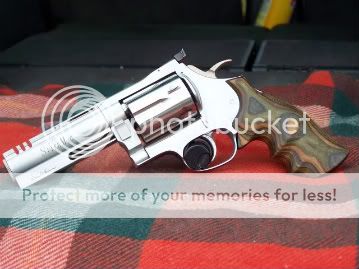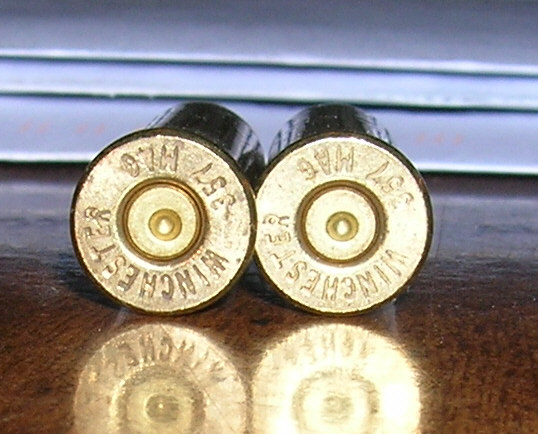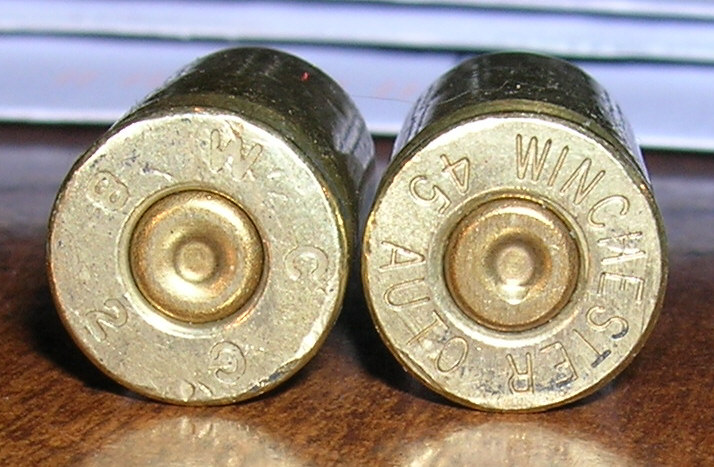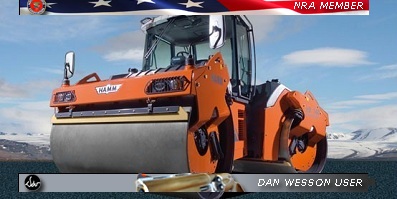December 12, 2009
 Offline
OfflineAsk superdan he has made 360 out of 357 Max brass, but he will tell you it is not a fun job. Most of his loadings are in 357 brass and he runs some different powder then the usual. We have a crony that said it was at 357 Super velocity. I know I got to try some of that powder and loads in Maximum. If your brave you use 353 Casull in place of magnum, but remember to go way light as I think the Casull just may have a larger frame??? Not positive on that. New brass is a must for them too. I was going to run some in test loads in my model 40 this spring. 

Dans Club
May 17, 2009
 Offline
OfflineRod,
Here's an article that should help:
http://www.lasc.us/RangingShotDanWesson360Revolver.htm#top
Ed

December 12, 2009
 Offline
OfflineI was talking to Dave today about 360 DW. You will need a lathe to turn the inside of the brass on a 357 max conversion, or some kind of jig. Just PM him he knows what your up too. We also talked about 353 and their is just to much pressure for that gun, around 60,000 (I THINK) for the 353 and somewhere around 46,000 for 360. So you mite start a few grains light and look for pressure signs. He has some kick ass data with AA9 that outrun my 357 maximum. 1600 fps with a 180 gr. we hit with that 360 and had no pressure, but a week or so later it was a hot day and it freaked out too. But most max users are used to this headache. Anyways PM superdan...
December 12, 2009
 Offline
OfflineA great posting for sure, we will drive it until we see flattening of the primers all the time with no problems. It is when they flatten to the point of seeing the tooling marks ( Lines ) in the primers, or a Cratering ( Primer Flow ) the pressure is excessive. This also is a good indicator for any type of reloading Pistol and Rifle. It has been my experience that sometimes you will not get a cratering in some guns, and will move to hard extraction then case failure. I have only had 4 case failures due to excessive pressures in 17 years, and always in development stage. On occasion a old piece of brass will split on a proven load, or a load that was developed in colder temperature will go to pressure in the summer heat. I am glad you had pictures of brass that suffered that, If I posted them pic's I would never here the end of it. My reputation is my name on the forum, I will develop every load to it's fullest potential, but safe to shoot and with a reasonable life to the brass. 
December 12, 2009
 Offline
OfflineOk we have pic's of brass that went over the limit, let's see some that ride on the limit... This is my hunting load for 357 Magnum, the crony gives 1430 fps with a 8 inch DW 15 it also was at 1486 fps in a Python, it is a 180 gr. Lasercast and 15.3 gr. of Little Gun and a Winchester primer. Note: This same load showed excessive pressure in a King Cobra, and a Security 6. Load with caution.
The next Pic is what happens when you take a max load for one gun, and put it in another. 45 ACP the one on the right is a max load for my Stainless Para 1911, 230 Lee with 5.3 gr. of A.S a Winchester primer and is almost 1000 fps. The one on the left is the same load in my Black Para 1911 same gun, and at the same time not the same gun.
The my other posting about running to hot will start to have primer flow ( cratering) in this pic the 357 Maximum just starts to show a little flow, this one is a great load and one of my favorites with a rifle primer, the one shown is a CCI 550 small pistol magnum, I run these at pin shoots for assured ignition, not a click when speed is a must. This load will be taken down 2 tenths of a gain and it, will be ready for competition.
I hope this will help you develop a good eye for a top of the line loading that can't be found on the shelf. Just keep in mind that if these loads were put together at 40 degrees, at 90 they just mite freak out... Use With Caution. 




December 26, 2010
 Offline
OfflineWow! That's an education that can't be bought for sure! Thank you very much for the great pics and explanations.
Another question, on hard to extract cases, do they stay hard to extract even after they have cooled? I had some hard to extract SM on the original cylinder on my SM. After sitting for five or ten minutes they came right out. Temperature was fairly warm that day as I recall. At the time I attributed the difficulty to carbon scoring from a lot of regular magnums having gone through it first.
Second question, how many time, generally, can a case be reloaded with safe loads? Just curiosity on my part is most of my brass is once fired factory loads.
Thank you very much.
December 12, 2009
 Offline
OfflineReload them until they fail, or the primer will not seat and falls out...lol. Just spend a few bucks and invest in a Lee hand case trimmer, grab a drill and size away with no chance of cutting them to short with the Lee. As for hard extraction, if you have some trouble with factory loads you just mite have a tight chamber, Not the first time we have seen that, a gunsmith will clean that one up for you, or if your willing get a piece of rod slice down the middle and work a piece of 000 steel woll on it and hook the other to a drill and try a polish on it first. As for some of that data, a loading of 14.6 will give 1350 to 1360 in a 8 inch DW 15. I have run it in a lot of hand guns with no serious pressure problems and have run at least 5 or 6 loadings on my brass with it, I ran it for 2 pin shooting seasons, no problems yet. And yes any metal that gets hot will expand, but you should be able to tip the gun up and have a few try to move or a little tap, and they fall out has long a you have clean cylinders, now if you have to hit it good, you got a problem. I would try a high end factory and see if it still has a issue, if not spec the factory load with a dial, in case you have die out of adjustment. If you get in a pinch just PM me, I will always lend a hand.
February 4, 2012
 Offline
OfflinePrimers can provide a good pressure indicator, but the same load with different primers can give different indications, even if the pressure is the same. It is widely known that CCI primers are 'hard' compared to some others, and I've found these are tougher to 'read' pressure signs from. If you know what is normal for the primer being used you know what is not normal already.
Primer flattening can occur sooner with looser primer pockets or excessive space between the cylinder and breech-face, but if you have flattening when developing a hot load which normally doesn't occur with that gun, you're getting hot- maybe too hot. Looking for breech face machining marks on the primer is good- use a magnifier. How a primer feels when it seats is another indicator and a good reason to only hand-prime your hot loads. Primer extrusion into the firing pin hole is another indicator, but that can be caused by an oversize hole too. Primer back-out without loose pockets is another indicator of high pressure or excess breech face gap.
You should get at least ten loads from a case before the primer pocket loosens. My hottest load goes only 5 so I know I'm on the ragged edge, and those cases all go in the trash when 3 of those 50 seat primers loosely. (I dry-fire the primers seated to that point to deactivate them) Measuring the case head diameter just above the rim is another good indicator. More than a few thou over once-fired size is getting hot. Remember all cases aren't born equal- some brands are softer than others. R-P seems to be best cases for my hot loads in .357 Mag among the major brands.
Only by having the professional equipment (pressure transducer) can you know the pressure you've got. Everything else is guesswork. Even knowing the exact pressure doesn't say everything- guns with tighter breeching tolerances and looser bores can tolerate hotter loads better than the reverse, and exceeding pressure SAAMI limits does not mean it's going to blow up on you.
Brass work-hardens after several resizings and is then more prone to split. For my light plinking loads split cases are when they get individually trashed. For hot loads in lesser-used cases it's a danger sign (and hot loads don't belong in many-times-used cases because of hardening making the brass brittle) One split case in a couple thousand may be due to manufacturing- more than that is almost always over-pressure in lesser-used brass.
Trimming brass to length is good but the brass has to come from somewhere, usually the area where the case head meets the case walls where head separations occur. Seeing a bright ring on the outside there often indicates a case head is about to separate. Some will dump the brass after a certain number of trimmings. It's more a sign of other things than pressure but it does indicate weaker cases that shouldn't be be loaded hot anymore.
Reading pressure signs is a combination of all of the above and every gun will read differently, even with the exact same loads. Everything is a variable that will read differently and only experience can tell you how relative what you're seeing is compared to actual pressure. Best advice is to stay within the recommended loads of reputable manuals and tread very carefully getting there or going beyond until you gain the experience to 'read' the pressure signs you can see and feel. When creating those loads measure (not meter) powder charges, use a single stage press so you can feel what's going on, hand prime for the same reason, measure the bullets, and reduce the load when you change anything.
Hot loads are like walking next to a cliff- you're probably OK so long as you know what you're doing and you're being very careful but one moments inattention or stupidity and you're gone. The closer you walk to that edge the more critical luck becomes, and if your luck is like mine you'll stay back from the edge a bit. Hot loads can be relatively safe but when you go there you're on your own and if anything goes wrong you have nobody to blame but you!
December 12, 2009
 Offline
OfflineShould also note that Wolf CCI are hot as well as hard, Remington is softer but still as hot, Winchester cools it down a little and Federal is the coolest. So if your nipping on pressure with a CCI a Winchester will show a little less and Federal you may even add more powder, to get it back up to performance. In most cases you want some of each lying around when working up maximum loads, Also bullets of the same weight will give different pressures too. The 357 little gun load at 15.3 will not be happy with a jacketed round, and even was a little unhappy with a gas checked bullet too. But a Lasercast and and other cast bullets that were tinned up worked good, the Lasercast still leads but after the round I just hit it with a dry brush and it comes right out. Of course if it was loaded down you have hardly any issue with them. Anyways have fun, but be safe. 
1 Guest(s)

 Register
Register Log In
Log In Home
Home




 . I have to watch the loads I guess, but I shoot them in a Dan Pointman so maybe not?
. I have to watch the loads I guess, but I shoot them in a Dan Pointman so maybe not?
 .
.
